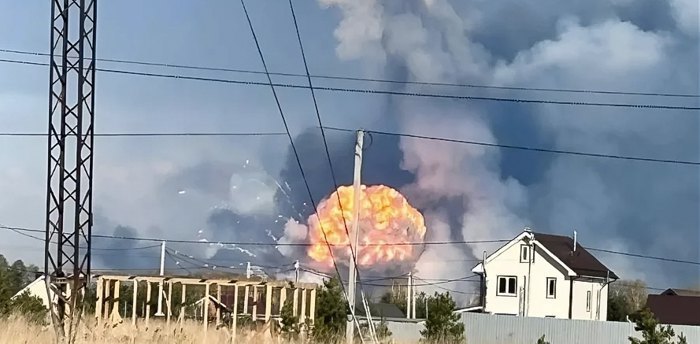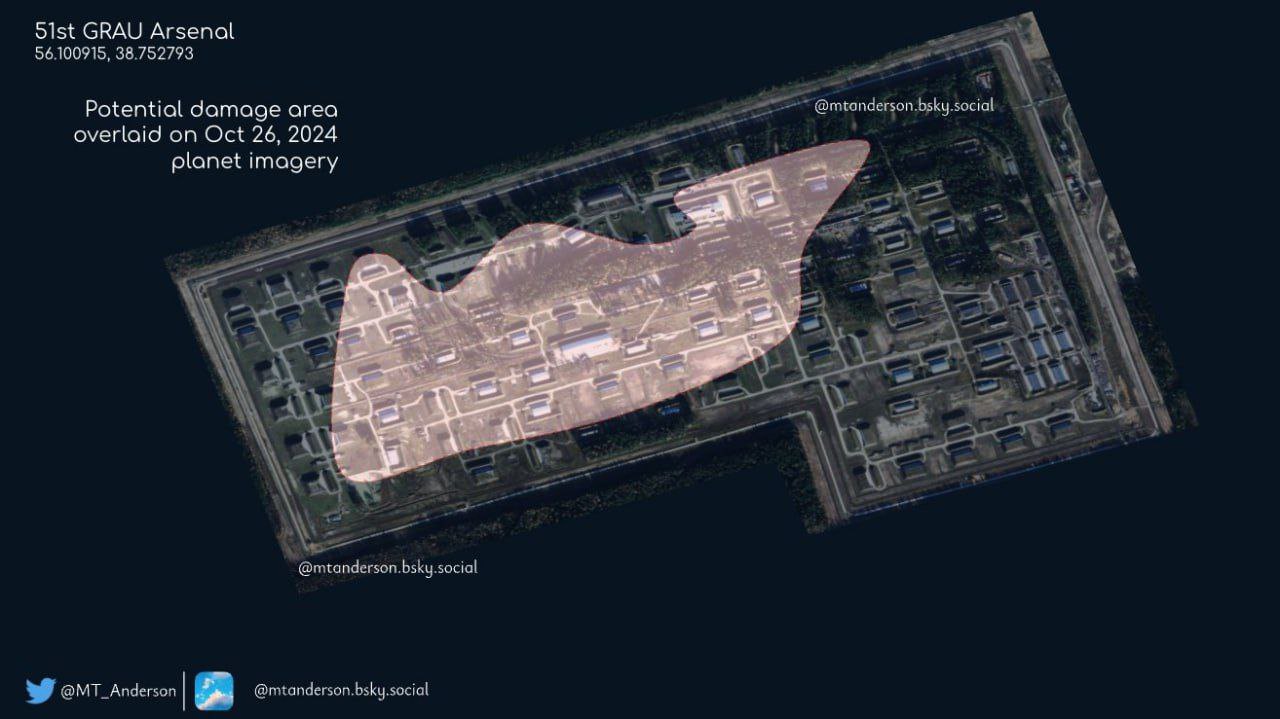The fire spread beyond the base, reaching the surrounding forest and preventing fire trucks and trains from approaching, cooling the roofs of the underground shelters and extinguishing the above-ground ones.
This was not a case of isolated fire spots from scattered missiles, but a massive blaze with an epicentre located at the heart of the arsenal.
The governor of the Vladimir Region stated that, indeed, the detonations continued throughout the night but are now subsiding – a common indicator in Russia that something significant has occurred.
Officials have made conflicting statements. Some refer to a violation of safety regulations, while others, even amid the evacuation of nearby villages, claim there is no danger.
There were at least five large ground-level ammunition storage sites filled with expired munitions – kilotonnes of rocket engines, decayed mines, and shells scattered across the base. It would have been impossible for the site to catch fire and for the arsenal to remain intact.
Several powerful explosions, each involving hundreds of tonnes of munitions, have occurred – shattering windows and sending fountains of flame and earth into the air. These were the underground storage facilities detonating.
Yet these account for less than half of the 80 warehouses and sites on the premises.
It is implausible to believe that the underground capsules ignited without affecting the structures above ground.
Rockets have been falling 8–10 kilometres from the epicentre for several hours, and fires have broken out in nearby villages. Had only one or two warehouses been destroyed in a simultaneous detonation, such widespread consequences would not have occurred.
Instead, it appears the warehouses were ignited one by one as the fire spread.
Since 2010, several waves of arsenal modernisation have taken place – capsule-style underground storage facilities were constructed, equipped with gates and fire extinguishing systems.
In 2017, the Russian Federation initiated pre-trial proceedings concerning this arsenal – 640 million roubles out of a 1.3 billion rouble budget had been embezzled.
Corruption kills – whether in Russia or Ukraine. This is why the fight against corruption is tied to every tranche and instance of international assistance to Ukraine – there is no point pouring water into a leaky bucket.

Given that Moscow’s air defence system, equipped with the S-300B, is capable of intercepting ballistic missiles and generally considered a strong system – and considering the nearby railway junction and many underground warehouses – the 51st Arsenal undoubtedly stored critical, high-tech military equipment.
This included anti-tank guided missiles (ATGMs), including those mounted on helicopters, air defence missiles (particularly S-300/400), various warheads for operational-tactical missile systems (OTRK), and precision-guided missiles – assets not easily serviced without control room equipment, qualified personnel, and proper maintenance capacity.
During the Great War, the 51st Arsenal likely served as a logistics hub: a place where weapons needing disposal or restoration were brought, along with supplies from Belarus, North Korea, and Iran as Russia’s own stocks dwindled.
Even without imports, the billions spent on fire suppression systems, vehicles, trucks, and now-destroyed electronic warfare systems represent a significant financial loss.

As for the ammunition – the value of a large city’s annual budget has likely gone up in flames. And this came just before the summer campaign – eliminating not only stockpiled munitions but also the capacity to restore them, cannibalise missile parts, and replace engines.
Located just 64 kilometres east of Moscow, it was a well-defended, strategically vital target – and taking it out is no small feat.
Shortly before the explosion, there were reports of Ukrainian Defence Forces drones operating in the region. Although there is no concrete evidence of missile strikes or dive-bombing of the Lutykh site, it would be beneficial if the resulting sabotage, subsequent investigation, and search for the perpetrators disrupted the arsenal’s remaining personnel for a prolonged period.
The destruction of several major arsenals – combined with Russia’s increasing reliance on Iran and North Korea for 70% of its military supplies – is a telling indicator of Moscow’s exhaustion. A supposed three-day war against a “fictitious country” has revealed its true nature.








